Introduction:
For plant enthusiasts, the joy of watching a tiny seed grow into a flourishing green beauty is unparalleled. However, along with the satisfaction of nurturing plant babies comes the lurking threat of pests and diseases. One such adversary that can wreak havoc on plants is the doppelganger strain.
Identifying the Doppelganger Strain:
The doppelganger strain is a cunning culprit that disguises itself as a common plant disease or pest, leading plant parents to misdiagnose and mistreat their beloved green companions. This deceptive strain manifests in various forms, masquerading as symptoms of known plant ailments, making it challenging to detect. Some common signs of the doppelganger strain include:
-
Yellowing Leaves: While yellowing leaves can be a sign of nutrient deficiency or overwatering, the doppelganger strain may mimic this symptom to deceive plant parents.
-
Leaf Spotting: Spots on leaves are often attributed to fungal or bacterial infections. However, the doppelganger strain can create similar patterns, causing confusion among plant owners.
-
Wilting or Drooping: Plant stress, underwatering, or root rot can cause wilting. The doppelganger strain capitalizes on this common symptom to evade detection.
Unveiling the Doppelganger Strain:
To unravel the mystery of the doppelganger strain and safeguard your plant babies, a keen eye and proactive approach are essential. Here are some strategies to unmask this impostor and protect your leafy companions:
-
Monitoring and Observation: Regularly inspect your plants for any unusual symptoms or changes. Note the progression of any issues and document them to track patterns.
-
Research and Education: Familiarize yourself with common plant diseases and pests to distinguish between genuine threats and the doppelganger strain. Utilize reliable resources and seek guidance from plant experts if needed.
-
Isolation and Quarantine: If you suspect the presence of the doppelganger strain, isolate the affected plant to prevent potential spread to other plants. Monitor the isolated plant closely to understand the nature of the issue.
-
Consultation: Don’t hesitate to seek help from local nurseries, plant forums, or extension services. Experienced plant enthusiasts can offer valuable insights and guidance in identifying and combating the doppelganger strain.
Combatting the Doppelganger Strain:
Once you’ve identified the doppelganger strain plaguing your plants, it’s crucial to take swift and targeted action to eliminate the threat. Here are some effective strategies to combat this deceptive adversary:
-
Natural Remedies: Explore natural solutions such as neem oil, insecticidal soaps, or fungicides approved for plant use. These gentle yet potent remedies can help manage the doppelganger strain without harming your plants.
-
Pruning and Sanitation: Trim affected leaves or parts of the plant to prevent the spread of the doppelganger strain. Dispose of pruned material carefully to avoid reintroducing the pest or disease.
-
Optimal Care Practices: Ensure your plants receive adequate sunlight, water, and nutrition to bolster their natural defenses against the doppelganger strain. Healthy plants are better equipped to resist and recover from attacks.
-
Biological Controls: Explore the use of beneficial insects or microbes that can combat pests and diseases organically. Introducing predators of the doppelganger strain can help maintain a balanced ecosystem in your plant collection.
FAQs (Frequently Asked Questions):
- How can I differentiate between a genuine plant disease and the doppelganger strain?
-
Pay close attention to subtle differences in symptoms, conduct research on common plant issues, and seek guidance from experienced plant enthusiasts to make an accurate diagnosis.
-
Can the doppelganger strain be transmitted to other plants in my collection?
-
Yes, if left unchecked, the doppelganger strain can spread to other plants. Isolating affected plants and implementing control measures are essential to prevent further infestation.
-
Are chemical pesticides the only solution to combat the doppelganger strain?
-
No, there are various natural remedies and holistic approaches that can effectively manage the doppelganger strain without resorting to harsh chemicals. Explore eco-friendly options for plant care.
-
How frequently should I inspect my plants for signs of the doppelganger strain?
-
Regular monitoring is key to detecting the doppelganger strain early. Aim to check your plants weekly for any unusual symptoms or changes in growth patterns.
-
What should I do if I suspect my plant is affected by the doppelganger strain but am unsure of the appropriate course of action?
- Reach out to local plant experts, nurseries, or online plant communities for guidance. Seeking advice from experienced individuals can help you navigate the challenges posed by the doppelganger strain.
In conclusion, staying vigilant, informed, and proactive is crucial in defending your precious plants against the deceptive doppelganger strain. By honing your observation skills, seeking knowledge, and implementing targeted interventions, you can safeguard your plant babies and ensure they thrive in a nurturing environment free from impostors.
